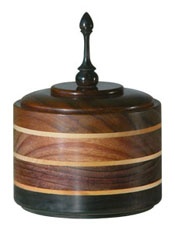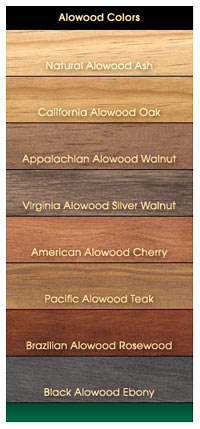
“Is there any way to dye solid wood all the way through?”
That’s one of the questions we frequently get here at the magazine, often followed by the explanation “I’d use fancy exotic wood but it is too unstable, too expensive, rough on tools and environmentally irresponsible.”
Until now the answer was always no, so imagine my surprise when I ran across just such a product at a woodworking show recently. There in front of me sat an assortment of solid wood boards, colored all the way through and made to look like cherry, walnut, ebony and a variety of other old friends, all sold under the trade name Alowood. When I delved further, I was in for even more surprises.
Not only does Alowood look good, it behaves itself as well, offering more stability and less wood movement than the exotics it imitates. Because it is offered as already dressed boards, it is easier to use and is typically cheaper than the wood it mimics. Best of all, it is made from easily available, fully sustainable wood.
“Alowood,” explained John Gibb, the managing director of EverTech, the company responsible for its creation, “is a dyed, stabilized version of very sustainable and available wood made to look like its more exotic or desirable brethren. The process starts with a wood like Radiata pine. Plant starch is dissolved and injected back into the wood with a crosslinking thermoset polymer. We fill up the cells of the wood with dye and starch, crosslink it, then evaporate off the water. The result is pine that is denser, stronger and harder than the original wood, and can be made in any possible color.
“In terms of twisting, cupping and bowing, Alowood is more stable than Radiata pine, and much more stable than many exotics. It will move like other woods, but less than most other woods. In fact, it moves about 30 percent less than Radiata, a wood already considered to be one of the more stable woods out there.”
“Alowood is perfect for people desiring to use unsustainable hardwoods,” added Karen New, the company’s director of marketing, “but who want real wood that looks and acts different than what is plentiful. In many ways it is the best of both worlds
“Because it is colored throughout,” she continued “it has the look and characteristics of fancier hardwood but is both cheaper and more consistent. It also offers the ability to mix wood colors together that otherwise would be problematic due to wood movement differentials. Because they all have the same property but look different, you can make more stable pieces that look like unstable exotic combinations.”
Though it hardly seems necessary with pre-colored wood, Alowood will take stain or dye. Of course, it is easily glued with all common wood adhesives. “Ironically,” Gibb pointed out, “the dyes we use will gradually fade, but only at the very surface of the wood, so it returns to the color you started with if you sand it. In that respect, it behaves exactly like the real thing, though we have found that Alowood fades much slower than most richly colored hardwoods.
“For a hobby woodworker who wants an exotic-looking coffee table but can’t afford ebony, for example, Alowood is ideal. It is easier to use than real exotic hardwood, and it’s not as hard on your tools. One teacher we sell to likes giving his students Alowood because they can make things that might be problematic using the real thing. We sell clear, sixteen-foot, one inch by six inch boards that are all identical. You can buy a stack of boards that have no knots, imperfections or wainy edges to get 100 percent yield and consistent color.”
Equally remarkable is that this product came about almost by accident. EverTech, the company responsible for it, is a joint venture between Chemco and MeadWestvaco. Chemco is a wood treatment and wood technology company that does, among other things, fire retardant pressure treatment using nontoxic materials. MeadWestvaco has a specialty chemical division that tries to find ways to recycle byproducts from their papermaking and packaging operations.
“One of the side effects of fire retardant is that it makes wood harder and more brittle,” Gibb explained. “We have always fought that because nailed shingles will break more easily. We spent years trying to get wood fire resistant but not hard. Conversely, there is a large wood modification industry in Europe trying to harden softwoods. This combination of needs, along with a declining market in fire retarding wood roofing, led us to explore another avenue.
“Meanwhile, a Japanese company named ADWorlz asked us to produce hardened Radiata pine with no phenolic or formaldehyde. We created a formaldehyde-free formulation that hardened wood and let us add color as well. After selling wood to them, we came to the attention of MeadWestvaco, which was trying to use pine extractives to harden wood for the flooring industry. They felt we were further along, so we got together and became a joint venture to take the wood to market. The result is Alowood.
“Though we currently use mostly yellow, Radiata and Ponderosa pine, the process can also be done on other woods, including some of the softer hardwoods like poplar, aspen and even soft maple. We are currently working with local hemlock to get that to work, and also working with Canada to treat otherwise wasted lodgepole pine trees that were killed by mountain pine beetles. The projection is that up to 50 percent of these trees will be destroyed by the beetle. Beetles used to get killed by freezing, but the warming global temperatures mean they are thriving, surviving year-round, multiplying and destroying lots of wood. We may be able to take this low value wood and improve both the quality and market value of it.”
One weakness of Alowood is that it is only appropriate for indoor use, but even that may soon change. “We are pursuing a technology that would take waste wood from pine, put it back into pine and create a wood that could be used outdoors,” Gibb explained. “Hopefully, it will be available by 2008.”
Conscious of the environmental impact of shipping, they aim to diminish that by selling the chemicals that create Alowood. You need pressure treating and kiln drying capabilities to thermoset the polymer, but they will sell to whomever would like to become a licensee. “We hope to set up more regional manufacturing facilities that would allow people to treat locally grown wood rather than shipping wood all over the world. That is the ultimate environmental footprint.
“We have frequently talked about the environment and how the average woodworker can make a difference,” Karen added. “All of our materials are both Greenguard certified, a status that relates to indoor air quality, and Forest Stewardship Council certified. We use plantation grown, sustainable, quickly grown wood for our products. This is wood you can feel really good about using.”
“Once this is readily available,” Gibb noted, “it will offer a wood that is easy to work with, exotic-looking, affordable and environmentally responsible.”
That sounds to us like a woodworker’s dream.








